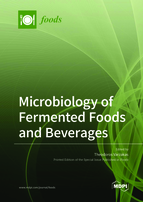Microbiology of Fermented Foods and Beverages
A special issue of Foods (ISSN 2304-8158). This special issue belongs to the section "Food Microbiology".
Deadline for manuscript submissions: closed (31 August 2018) | Viewed by 81415
Special Issue Editor
Interests: food technology; food engineering; food safety; food quality; extra virgin olive oil; mycotoxins; fermented foods
Special Issues, Collections and Topics in MDPI journals
Special Issue Information
Dear Colleagues,
Fermented foods are food substrates that are invaded or overgrown by edible microorganisms whose enzymes, particularly amylases, proteases, and lipases, hydrolyze the polysaccharides, proteins and lipids to nontoxic products with flavors, aromas, and textures pleasant and attractive to the human consumer. Fermentation plays at least five roles in food processing: (1) Enrichment of the human dietary through development of a wide diversity of flavors, aromas, and textures in food; (2) preservation of substantial amounts of food through lactic acid, alcoholic, acetic acid, alkaline fermentations, and high salt fermentations; (3) enrichment of food substrates biologically with vitamins, protein, essential amino acids, and essential fatty acids; (4) detoxification during food fermentation processing; and (5) a decrease in cooking times and fuel requirements (Steinkraus, 2002).
Classified fermentations include:
Fermentations producing textured vegetable protein meat substitutes in legume/cereal mixtures.
High salt/savory meat-flavored/amino acid/peptide sauce and paste fermentation.
Lactic acid fermentations. Examples of vegetable lactic acid fermentations are: sauerkraut, cucumber pickles, and olives in the Western world.
Alcoholic fermentations.
Acetic acid/vinegar fermentations.
Alkaline fermentations.
Leavened breads.
Flat unleavened breads.
The aim of this Special Issue is to describe in detail and advance all these fermentations, describing, not only the microbiology behind, but also the principal technologies of fermented foods and beverages.
Prof. Dr. Theo H Varzakas
Guest Editor
Manuscript Submission Information
Manuscripts should be submitted online at www.mdpi.com by registering and logging in to this website. Once you are registered, click here to go to the submission form. Manuscripts can be submitted until the deadline. All submissions that pass pre-check are peer-reviewed. Accepted papers will be published continuously in the journal (as soon as accepted) and will be listed together on the special issue website. Research articles, review articles as well as short communications are invited. For planned papers, a title and short abstract (about 100 words) can be sent to the Editorial Office for announcement on this website.
Submitted manuscripts should not have been published previously, nor be under consideration for publication elsewhere (except conference proceedings papers). All manuscripts are thoroughly refereed through a single-blind peer-review process. A guide for authors and other relevant information for submission of manuscripts is available on the Instructions for Authors page. Foods is an international peer-reviewed open access semimonthly journal published by MDPI.
Please visit the Instructions for Authors page before submitting a manuscript. The Article Processing Charge (APC) for publication in this open access journal is 2900 CHF (Swiss Francs). Submitted papers should be well formatted and use good English. Authors may use MDPI's English editing service prior to publication or during author revisions.
Keywords
Fermented foods
Fermented beverages
Microbiology
Lactic acid fermentations
Alcoholic fermentations
Other fermentations







